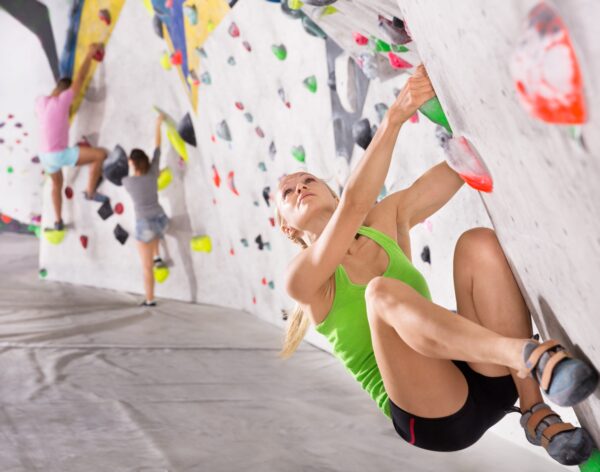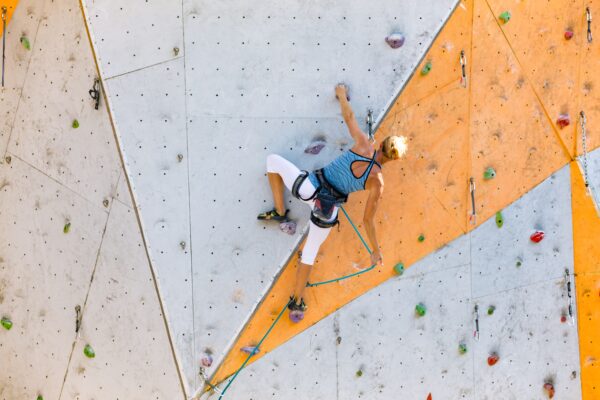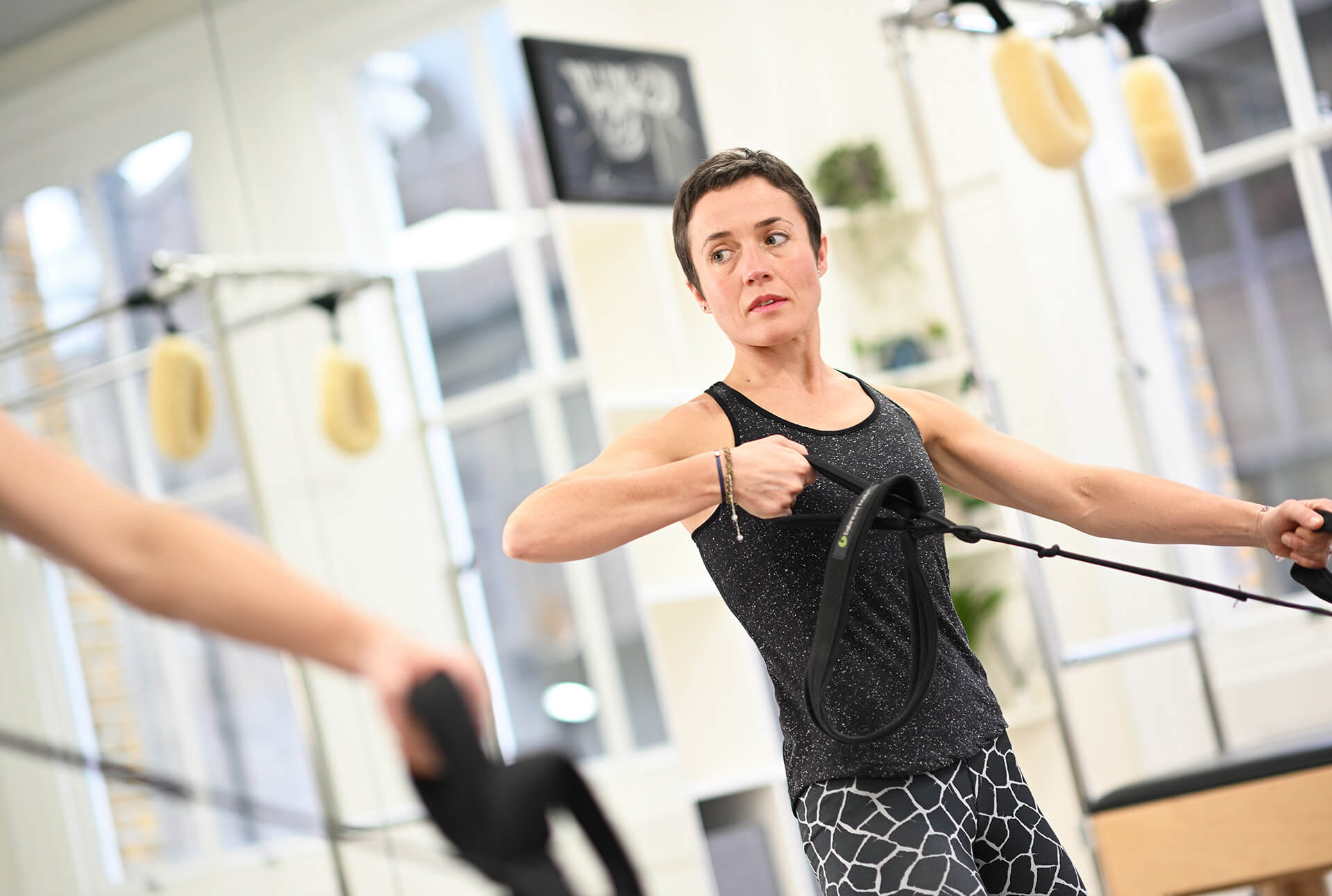Author: Begum Komurcuoglu is a chartered physiotherapist and Polestar certified Pilates instructor with a special interest in sports rehabilitation.
Have you noticed the explosion in climbing walls around the country over the past few years? Are you a rock climber yourself? Are you wondering whether Pilates can help improve your climbing?
Sport climbing has increased incredibly in popularity in the last 25 years, even making its debut in the Summer Olympics in the 2020 Tokyo Games. Climbers can participate in the sport in outdoor and indoor settings, recreationally and competitively.
Outdoor climbing occurs across a vast range of environments and can be further categorised based on the technique and equipment used to scale the route. Indoor climbing involves artificial surfaces to mimic an outdoor environment, but as it offers a controlled setting, it allows for greater participation.
What are the different types of indoor climbing?
Indoor climbing can be divided into bouldering, speed climbing or top rope, or lead climbing.
Bouldering

Bouldering is free climbing on routes that are lower in height, without the use of ropes or harnesses
Lead climbing

Climbers clip on to the permanently fixed bolts and anchors on the rock face as they ascend the route.
Top rope climbing
In top rope climbing the climber is supported by a rope that is anchored at the top of the route, and controlled by a belayer standing on the ground.
What are common injuries in climbing?
As the accessibility and popularity of the sport increases, so does the incidence of climbing related injuries. The risk factor for injuries will change depending on the type of climbing:
Bouldering has the greatest injury rate due to being performed without a rope and the large dynamic movements required
Lead climbing has the next greatest risk of injury. Anchors are present at variable intervals, but large falls can still occur
Top rope climbing has the lowest risk of injury as large falls is relatively non-existent with an adequately trained belayer present to catch the climber if they fall off the wall
Chronic injuries most commonly involve the arms, as most climbing is done with the arms above the head.
The shoulder is the second most injured site, following the finger and hand injuries. It represents 40% of all upper body injuries and 17% of all climbing injuries. Shoulder injuries may include
- Rotator cuff tears
- Impingement
- Bicep tendonitis
- SLAP tears
The shoulder is a ball and socket joint with a great amount of mobility, as it is very shallow. The shoulder relies on muscles to provide stability of the joint in overhead positions.
Related links: Shoulder exercises at home
The highest risk factor for injuries is the amount of time spent on the wall. Climbers practice moves repeatedly that may push the absolute limit of their physical and technical level. The repeated strenuous movements may eventually cause a soft tissue injury. Correct climbing form is key to injury prevention.
Biomechanics of climbing
Rock climbing requires a combination of muscular strength, power, and endurance. It is also characterised by continuous change between dynamic and isometric contractions by the muscles.
Isometric contractions are when the climber is using a specific group of muscles but not actually moving, therefore the length of the muscle remains the same, so no visible movement occurs.
During dynamic contractions, the length of the muscle either lengthens or shortens when the climber is using the specific group of muscles. There will be visible movement of the body.
Isometric contractions play a key role in climbing because they are used to stabilise the climber’s body position on the wall. On average, 38% of climbing time is spent in static positions. Dynamic contractions occur to move the body along the wall, either going up the wall, climbing down or going for a big dyno move.
Pulling muscles, such as biceps and latissimus dorsi, are extensively used during climbing to move the body vertically and horizontally along the wall. Pushing muscles, like the triceps, are used in positions when the climber is stabilizing themselves with their arms lower than the shoulder level.
Just like all sports, core muscles are very important in achieving efficiency of movement. In climbing, for example, when legs lose contact with the wall, like in overhang positions, core muscles contribute to bring the body back and position it on the wall.
Do climbers need core strength?
Definitely! Relying solely on arm and grip strength will cause fatigue quickly when scaling up a route. Therefore, it is important to engage the core, back and the muscles around the shoulder blades to assist the arms and the grip.
Although it is important to train grip strength on equipment such as finger boards, training the core muscles has a great carryover to climbing performance. Climbers always use their core when on the wall, while resting, placing gear, planning their route, or just calming themselves down.
Core muscles are also important when winding up for an explosive dynamic move. These muscles keep the climbers against the wall and allow forces to transfer from one end of the body to another during movement.
Therefore, combining core stability exercises with stability exercises will be an effective way to prevent injuries in climbing.
Pilates exercises for climbers
Most climbers will focus on getting stronger, doing exercises such as pull ups, muscle up and weighted dead hangs. These exercises will get the dynamic movement muscles stronger, but training the stabiliser muscles is just as important.
Stabiliser muscles work at a lower intensity but for a longer period. They also assist with using the pull/push muscles more efficiently.
The following exercises focus on shoulder stability, since the shoulder is one of the most injured joint in climbing. The exercises combine core stability along with shoulder stability to help you move along the wall with more strength and control.
Pilates exercises for climbers: scarecrow exercise
Scarecrow is a great exercise strengthen back and shoulders but also improve the range of movement of the shoulders and upper back.
Pilates exercises for climbers: T’s, Y’s and I’s on gym ball
These three exercises are great to strengthen the rotator cuff and back muscles, along with neck stabilisers as well. They also improve shoulder and upper back mobility, help with postural correction. A common complaint for climbers is that they may lack mobility in shoulders, therefore these would be great as a warm-up to prep getting on the wall.
Pilates exercises for climbers: side plank
Side planks are a great exercise to work the deep stabilising muscles of the hip, core and the shoulders. Doing any kind of weight bearing exercises with the arms improves shoulder strength, stability, and proprioception (the sense that lets us perceive where the body part is in space, and the movement of that part).
Improving proprioception is very important when climbing, as the climbers need to be very aware of where their extremities when they are reaching for holds. The following variations are progressions of side planks:
Side plank with rotation
Side plank with knee drive
Side plank with hip dips
Pilates exercises for climbers: Plank with shoulder taps
Adding the shoulder taps to a traditional plank adds an anti-rotation component to the exercise. These exercises challenge the core by resisting a rotational force. When performing the shoulder taps, the body wants to rotate side to side as you shift from one hand to the other. Trying to resist that rotation will engage the core and the obliques
Pilates exercises for climbers: Plank with band pull down
Another great plank exercise that adds an eccentric contraction for the latissimus dorsi muscles (“lats”). Therefore, the muscle lengthening under tension as the arms extends out in front in a controlled manner.
This type of contraction is important when catching yourself after a dyno, as well as climbing down the wall. Not only does being in the plank position build shoulder stability but the pull-down component strengthens the lats and improves shoulder mobility.
We hope you have enjoyed this exercise series!
Now that you have read more about Pilates for rock climbers – do you think Pilates could help you? Complete Pilates specialises in 1:1 Pilates training, using large Pilates equipment . We’d love to talk to you to discuss whether we can help you with your goals!
Education is key:
These blogs are designed to give information to everyone, however, it is important to remember that everyone is different! If you have not seen one of our therapists and have any questions about injuries, what you have read or whether this may be useful to you, please just ask. We are more than happy to help anyone and point you in the right direction. Our biggest belief is that education is key. The more you understand about your injury, illness and movement, the more you are likely to improve.





